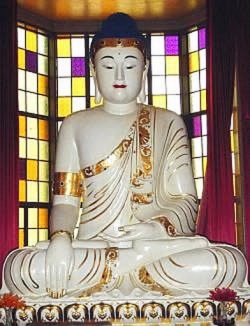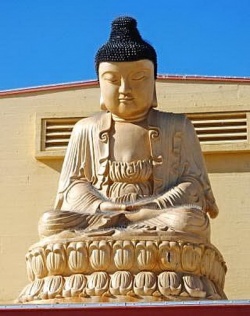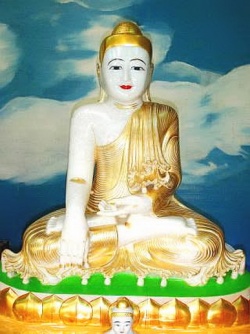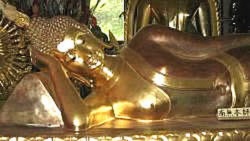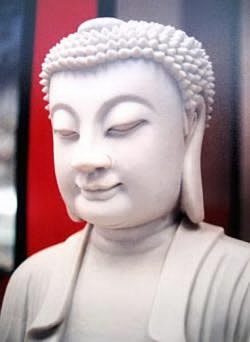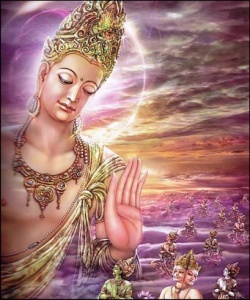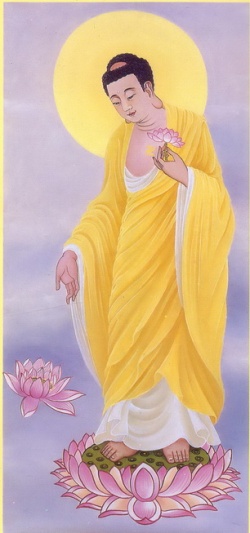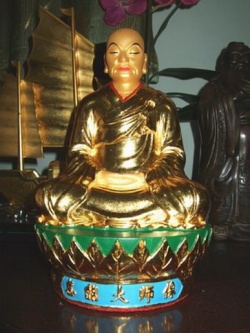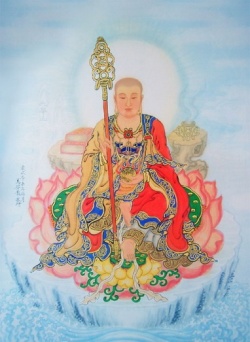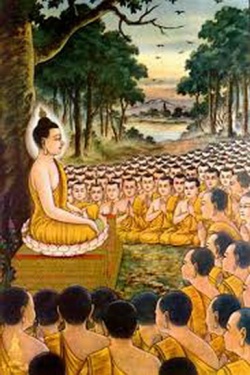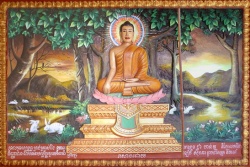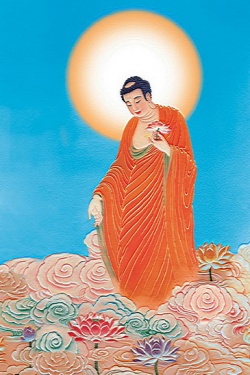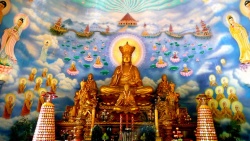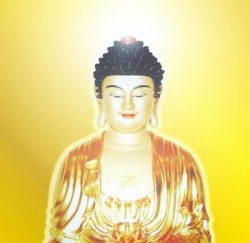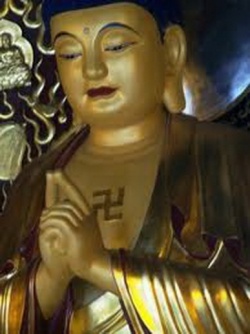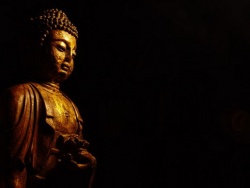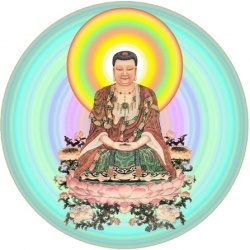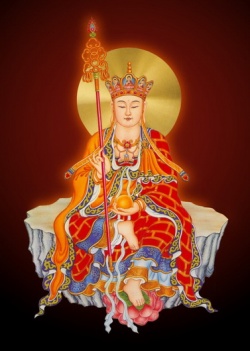The Platform Sutra of the Sixth Patriarch
Ven. Sheng-yen; translated by Yu Chun-fang
Chung-Hwa Buddhist Journal no.5 July 1992 Chung-Hwa Insitute of Buddhist Studies P.319-340
This Essay in Chinese Written by Rev. Sheng-yen was previously published in Vol.3, Chung-Hwa Buddhist Journal
Faith and tradition have held that the Platform Suutra of the Sixth Patriarch (Liu Tsu T'an Ching) was preached by the sixth patriarch of the Ch'an school, Master Hui-neng (638-713). However, since the discovery of the Tunhuang edition of the text, there has been much controversy among Japanese and Chinese scholars concerning the authorship of this classic. Was it based on the Sixth Patriach's thought, or was it a forgery by Shen-hui (668-760)? In this paper I will not discuss these debates. Instead, I will concentrate on the thought of this text.
There are two different editions of the Platforms Sutra contained in the 48th volume of the Taisho Tripi.taka. The first one, which is commonly called "The Sixth Patriarch's Platform Suutra unearthed from Tun-huang", has a very long title: Southern School Sudden Doctrine, Supreme Mahaayaana Great Perfection of Wisdom: The Platform Suutra Preached by the Sixth Patriarch Great Master Hui-neng at the Ta-fan Monastery in Shao-chou (Nan-tsung t'un-chiao tsui-shang ta-cheng mo-ke-pan-jo p'o-lo-mi ching Liu Tsu Hui-neng Ta-shih yu Shao-chou Ta-fa^n ssu shih-fa t'an ching).The second edition is entitled The Dharma Treasure Platform Suutra of the Great Master the Sixth Patriarch (Liu Tsu Ta-shih fa-pao t'an ching) .This edition is the most widely circulated and has been commonly used in China. It was compiled by the monk Tsung-pao during the chih-yuan era (1335-1340) of the Yuan dynasty, while the Tun-huang edition was compiled by Fa-hai who was the disciple of the Sixth Patriarch. It would seem that the Tun-huang text should be more reliable. Moreover, because the Tsung-pao edition reads more smoothly, we may presume that this was the result of improvements made by later generation through transmission, copying and literary embellishments of the text. Recently, a third edition which is known as the Ts'o-chi text has also come to light. This was a variant copy of the Tsung-pao edition. There are considerable differences among the three texts in terms of wording. The Tun-huang edition in particular differs from the other two in the sequence and order of its paragraphs. From these we can conclude that the three editions belong to two different textual traditions. We should not, however, assert that the original materials contained in Tsung-pao's edition necessarily postdated those found in the Tun-huang edition. Such academic questions concern evidential study of the redaction of texts—an issue which I shall not go into here.
What I would like to discuss instead in this paper is the thought of the Platform suutra. In doing so, I shall consult all available editions of this text. Using the commonly shared materials which are found in these editions, I will offer a comprehensive analysis of this scripture, synthesizing the key points emphasized in the three editions.
The System of Thought of the Platform Suutra
As is generally known, Ch'an Buddhism was transmitted from India by Bodhidharma who, arriving in China in 527 A.D., eventually became known as the First Patriarch of the Chinese Ch'an school. The foundational basis of his thought came from the La^nkaavataara suutra. Ching-chueh, the disciple of Shen-hsiu of the Northern school, wrote the Record of Masters of the La^nkaavataara (Leng-chia shih tzu chi) in which he introduced the system of transmission of Ch'an Buddhism from India to China. One can deduce form this that the mainstream of Northern Ch'an was based on the thought of La^nkaavataara suutra. However, for the Sixth Patrriach Hui-neng of the Southern school, although he accepted this scripture, he nevertheless regarded the Diamond suutra as the foundational basis for his own method of Ch'an. Because of this, when one analyzes the content of the Platform suutra, one can detect strong presence of tathaagatagarbha ( ju-lai-tseng ) thought due to its indebtedness to the La^nkaavataara suutra. At the same time, because it also inheritated the though of perfection of wisdom system, it puts special emphasis on praj~naa wisdom. Philosophically, the thought of perfection of wisdom belongs to the system of suunyataavada and Maadhyamika, whereas the La^nkaavataara belongs to the system of vij~naanavada and tathaagatagarbha. The two represent totally different systems of Indian Mahaayaana Buddhism. It is therefore very interesting to see how the Platform suutra manages to combine the two systems of Maadhyamika and tathaagatagarbha together.
In point of fact, Platform suutra uses wisdom as the method and regards tathaagatagarbha as its goal. It employs the perfection of wisdom's view of emptiness to destroy the attachments caused by passions in order to achieve the goal of "realizing one's clear mind and seeing one's true nature" (ming-hsin chien-hsing).The so-called "clear mind" refers to the pure mind devoid of passions; and "seeing into the true nature" means the seeing of the Buddha nature within one which is no different form that of the Buddha. Buddha nature is another name for tathaagatagarbha, and pure mind is an alternative name for praj~naa wisdom. The scripture uses the praj~naa wisdom in order to accomplish the purpose of seeing into one's true nature and becoming a Buddha. Although the two have different names and come from different sources, they are in fact the two sides of one entity. If you get hold of the one, you will also have the other. On the other hand, if you do not see the one, you will also be unable to attain the other. In other words, when one's mind is clear, one will see into one's true nature. Conversely, if one sees into one's true nature, one's mind must by necessity be completely clear and bright.
When we look at praj~naa from the standpoint of Maadhyamika, once wisdom is attained, the self-nature of all dharmas will be seen as empty. This is the goal. Aside form this, we do not search for tathaagatagarbha, Buddha nature, dharma nature or any other goal. However, when we look at the situation from the point of view of the tathaagatagarbha system, then praj~naa is only the funtion, but not the essence. Function must belong to something else. That is why there arises the thought of tathaagatagarbha and Buddha nature. For this reason, although we can detect the thought of praj~naa in the Platform suutra, the text is actually based on the foundation of tathaagatagarbha. This fact cannot be denied.
Perfection of Wisdom Thought in the Platform Suutra
The Platform suutra uses two scriptures representing the perfection of wisdom philosophy. The first one is the Diamond suutra and the second one is Perfection of Wisdom Suutra Spoken by Ma~nju'srii. We can find the following passages in the Platform suutra which either refer to the Diamond suutra or quote from the latter directly.
1. In the chapter " One practice " ( Hsing-yu ): "When Hui-neng heard the sentence, 'One should give rise to the mind which abides nowhere, ' he immediately became enlightened. He asked the man what suutra he was reciting, the answer was Diamond suutra."(T.48: 348a; T.8:749c)
2. In the same chapter : " The scripture says, 'All phenomena are illusory."' (T.48:348c; T.8:749a)
3. Again in the same chapter : " The patriarch spread his cassock around Hui-neng so that no one can see him and lectured the Diamond suutra for him. When he came to the sentence 'One should give rise to the mind which abides nowhere, ' Hui-neng immediately achieved great enlightenment." (T.48:349a)
4. The entire chapter entitled " Praj~naa " discusses the significance of perfection of wisdom. It emphasizes the chanting of Diamond suutra, for doing so will lead to seeing into one's true nature. It also says, "When one listens to the Diamond suutra, one's mind will open resulting in enlightenment." It refers to this method of practice as "praj~naa samaadhi" (pan-jo san-mei).(T. 48: 351 a-b)
5. The chapter " On calm and Wisdom" There are two translations of this suutra contained in the Taisho Tripi.taka. The first one was translated by Man-t'o-lo-hsien in two volumes (T.8, No.232) and the other one was translated by Chia-p'o-lo in one volume(T.8, No.233). "samaadhi of oneness" (T-hsing san-mei) which is found in Perfection of Wisdom Suutra Spoken by Ma~nju'srii in explaining the statement "Straighforward mind is the place of practice; straightforward mind is the Pure Land" emphasized by the Vimalakiirti suutra.(T.48:352c; T.8:731)
Let us now discuss further the thought and goal of these perfection of wisdom scriptures quoted in the Platform suutra. First of all, one cannot emphasize enough the central importance of the sentence "Give rise to the mind which abides nowhere" from the Diamond suutra for the thought of Platform suutra. Because Hui-neng's stress of this idea, he became the greatest Ch'an master in the history of Chinese Ch'an Buddhism. For although this sentence contains the essence of the teaching of Diamond suutra, it is not necessarily the most important passage. Usually, when we discuss the Diamond suutra, the following passages always receive attention: "There is no characteristics of dharma, nor is there characteristics of non-dharma." "Do not become attached to either dharma or non-dharma." "There is neither dharma nor non-dharma." All these sayings aim at the destruction of attachment. We should become attached to neither being nor emptiness. Not only the attachment to being involves being, even the attachment to emptiness also falls into the extreme of being. For "emptiness" (kung) and "being" (yu) are opposed to each other. But according to this favorite quotation beloved by Hui-neng, although it highlights the centrality of "non-abiding", it nevertheless still mentions the "mind". This mind manifests itself phenomenally as the mind of wisdom. "Non-abiding" refers to our not abiding in the mind of passion. But although we do not abide in the mind of passion, we still must discover the mind of wisdom. Because we need this mind of wisdom in order to seek the pure Buddha nature. We also need wisdom in order to save all sentient beings. Therefore, there is "being", and not "emptiness". If we link this sentence with what goes before in the Diamond suutra, we read that when a bodhisattva who has purified his/her mind beautifies the Buddha land, it is the same as not beautifying it, and only in this manner can we say that the bodhisattva has beautified the Buddha land. What this means is that when we in performing all deeds of goodness regard it as no different from not performing it, only then can we be said to be performing all deeds of goodness. Indeed, this mind of purity is the same as the mind of wisdom which attaches to nothing. When the Sixth Patriarch Hui-neng achieved awakening upon hearing this sentence, he achieved accord with the mind of wisdom. However, the Diamond suutra only talks about the experience of awakening, which in and of itself is the purpose. It does not identify Buddha nature as that which is being realized. This is different from the understanding of the Sixth Patriarch.
When the sentence "All phenomena are illusory" from the Diamond suutra is viewed in context, it means that the physical characteristics of the Tathaagata should not be seen as representing the real Tathaagata. Because the Tathaagata cannot be measured or limited by his physical characteristics, or in other words, because the Tathaagata permeates all phenomena yet, at the same time, is not identified with any phenomenon, we cannot single out any one particular characteristic as belonging to the Buddha. It is only when we are not attached to any one phenomenon that we can truly see the Buddha. That is why the sentence after this goes, "When you see all phenomena as non-phenomena, then you see the Tathaagata." From the point of view of Platform suutra, however, although phenomena are illusory, the nature of mind is nevetheless real. Therefore, we read in the Platform suutra, "Realize one's original mind, and see one's original nature." "Originally there is neither birth nor extinction." (T. 48: 349a) Such "original mind" and "original nature" which is neither born nor destroyed cannot be seen in the Diamond suutra. In this regard, the Platform suutra shares the same thought as found in La^nkaavataara suutra which also holds the view that while phenomena do not exist, nature does.
Although the Platform suutra does not identify Perfection of Wisdom Suutra Spoken by Ma~nju'srii by name, the "samaadhi of oneself" which it advocates comes from the latter. Moreover, the Fourth Patriach Tao-hsin had already mentioned this practice in his The Essential Dharma Door of Expedience in Entering the Way and Pacifying the Mind (Ju-tao an-hsin yao fang-pien fa-men). This method of practice was advocated because his goal was to use the teaching "The mind which recites the name of the Buddha is the Buddha" put forward in this suutra to explain the teaching "The mind is the foremost among all the buddhas" found in the La^nkaavataara suutra. In this suutra, before the practitioner reaches the state of "samaadhi of oneself", he is advised to "reside in a quiet place, give up all random thoughts and forsake attachment to external phenomena, concentrate the mind on a single buddha and chant his name exclusively." After the practitioner enters into the "samaadhi of oneness", he reaches the state where "the dharma-realm" is of one mark. When he acts in conformity to the Dharma-realm, this is the samaadhi of oneself. Since he conforms to the dharma-realm, there is neither regression nor destruction. It is unconceivable. There is neither obstruction nor marks." We now can understand that in referring to "samaadhi of oneself" Platform suutra is interested more in the goal of cultivation than in the perfection of wisdom thought. Moreover, the emphasis is more on the "samaadhi of oneness" itself than in the method of entering in the samaadhi. That is why Platform suutra says, "Always practice the straightforward mind at all times, walking, staying, sitting and lying." This passage is not found in Perfection of Wisdom Suutra Spoken by Ma~nju'srii, but its meaning agrees well with the teaching of Vimalakiirti suutra. Because the dharmarealm is characterized by sameness, there is neither obstruction nor marks. Because there is no obstruction, the daily life of walking, staying, sitting and lying is already in the state of samaadhi. In a much later Ch'an text Gateless Gate (wumen kuan), we read the statement, "Naaga [Dragon---another name for the Buddha) is always in samaadhi. There is no time that he is not in samaadhi." (T.48: 298b) This is the function of wisdom.
As for the term " samaadhi of wisdom " (pan-jo san-mei), it is only found in the Platform suutra but not elsewhere. The method of practicing "wisdom action" (pan-jo hsing) is to chant Diamond suutra single-mindedly and in doing so, one can enter into profound dharma-realm and the "samaadhi of wisdom". The so called "wisdom action" is to separate from all environment yet without giving rise to the notion of either birth or extinction. In doing so, one reaches the state of "coming and going with total freedom, the essence of the mind is not attached anywhere." (T.48: 351b) This is the great wisdom which "does not abide anywhere, and neither comes from anywhere or goes anywhere." When one uses this wisdom to observe all dharmas, one can attain the state of "no-thought, no-rememberance and nonattachment" which is no other than the "samaadhi of wisdom" resulting from seeing into one's nature and realizing buddhahood.
Platform suutra also puts much emphasis on the phrase "Mahaa Praj~naapaaramitaa" (Great Perfection of Wisdom) which should be chanted with a pure mind by the sa^ngha in order to attain wisdom. In chanting this phrase one should not merely do so with one's mouth, but must chant it with coordination between the mouth and the mind. (T. 48: 350a) This is obviously a method of spiritual cultivation. Hui-neng takes "mahaa" to be the vast limit of the mind which is as limitless as the empty space. There is not even one dharma to be obtained, for one's self-nature is truly empty. But although Platform suutra speaks of emptiness, it also warns us against sitting quietly with the mind fixed on emptiness, for doing so makes us fall into a neutral kind of emptiness (wu-chi kung) (Ibid). What this means is that while we should not be attached to any dharma, we also should not allow our minds to become empty and hollow. This is to affirm the point of view of "giving rise to the mind which abides nowhere" form the method of cultivation. At the same time, it negates the general mistaken view that the state of awakening is characterized by "sunken emptiness and stagnant silence". The awakening of the Ch'an school refers to the mind which is fully alive to lively demands of daily living, yet undisturbed by any external circumstances.
Nirvaa.na and Vimalakiirti Thought in Platform Suutra
In different suutras, tathaagatagarbha receives many different names, yet all refer to the same reality, for instance, Buddha-nature (Fo hsing), Self-nature (tzu-hsing), Dharma-nature (fa-hsing), Original Nature (pen-hsing) , Storehouse of Tathaagata (Ju-lai tsang), Storehouse of Dharma (fa-tsang), True Suchness (chen-ju), and Pure Mind (ch'ing-ching hsin) and so on. According to the Platform suutra, the Sixth Patriarch Hui-neng explained the subtle meaning of the Great Nirvaa.na suutra to the nun Wu-chin-tsang. He himself was also said to have visited the Dharma Master Yin-tsung who lectured on the same suutra at the Fa-hsing Monastery in Canton. The doctrine of "all sentient beings are possessed of Buddha nature" comes form the Great Nirvaa.na suutra. The faith in the thought of Buddha nature was extremely popular during the time of the Sixth Patriarch Hui-neng. The Vimalakiirti suutra (5) is quoted in several places in Platform suutra:
1. In the chapter " Wisdom " (Pan-jo pin): " The Ching-ming [Vimalakiirti] suutra says, 'When one achieves a breakthrough, one returns immediately to one's original-nature." (T.48:351a)
2. In the chapter " Questions " ( Yi-wen pin ) : "That is why the Buddha said, 'Because the mind is pure, that is why the Buddha Land is pure."' (T.48:352a)
3. In the chapter " samaadhi and Wisdom "(Ting- hui pin): "As it is stated in Ching-ming suutra, 'The straightforward mind is the place of practice, and the straightforward mind is the Pure Land."' (T. 14:520b; 14;538c)
4. In the same chapter we find: " Saariputra sat leisurely in meditation in the forest and was scoled by Vimalakiirti." (T.48:353a)
5. Again in the same chapter, we read: " That is why the suutra says. "While one is skillful in distinguishing various dharmas, one is unmoved in regard to the First Principal."' (T. 48: 353a; T.14:357c)
6. In the chapter " One practice" : " The Buddha Dharma is the method of nonduality." (T.48:349c) This comes from the chapter entitled "Entering the Dharmam Door of Non-duality: of the Vimalakiirti suutra. (T.14:550b-551c)
Judging from the above quotations from the Vimalakiirti suutra, we can see that it has exerted an enormous influence on the Platform suutra. We can at once mention five key areas where the thought of Vimalakiirti suutra has a direct bearing on that of Platform suutra. They are: (1) The view on sudden enlightenment; (2) the view of pure mind and straightforward mind; (3) the view that the daily life of walking, staying, sitting and lying is no different from cultivation; (4) the view on the unity between movement and quietitute and (5) the view on non-duality. Let us now discuss each of these in some detail.
1. The thought of sudden enlightenment comes from the tradition of "classification of Buddhist teachings" (chiao-hsiang p'an-shih). In the history of Buddhism during the T'ang dynasty (618-907), many systems of classifying the Buddhist scriptures which had been brought over from India to China had been proposed
2. The Platform suutra uses "straighforward mind" (chih-hsin) and "pure mind" (ching-hsin) to explain wisdom. It regards wisdom as the function of Buddha nature and pure mind, while taking the unmoving self-nature as "samaadhi" (ting) . Therefore, "samaadhi" and "wisdom" have a comparable relationship as that between the lamp and its light. (T.48:352c) If there is no light, it is not a lamp. But if it is a lamp, it must have light. The two are non-dual. The mind of the "straighforward mind" is no other than the mind of purity. The reason why a person has the mind of purity is because he/she has already seen the Buddha nature through wisdom. The essence and function are non-dual. If a person acts with the straigh-forward mind, it must be the pure mind, and in doing so, he/she will definitely see the Buddha nature. For this reason, the Sixth Patriarch advises people not become attached to all dharmas external to the mind. Only when one departs from vexations will one attains enlightenment.
3. The idea that daily living is no other than cultivation was intimately related to the tradition of monastic Buddhism of southern China. There, physical labor was necessary in order to maintain livelihood. This was also connected with the attempt to popularize Buddhism. Moreover, Hui-neng himself was originally a wood-cutter who, upon hearing a sentence from the Diamond suutra was said to have "achieved enlightenment right away". (T.48:349a) After he went to the Fifth Patriarch's monastery, he worked in the kitchen doing all kinds of menial jobs. Even after he achieved thorough awakening, he again worked as a helper among a group of hunters. That was why he did not feel the necessity of practicing sitting meditation for the purpose of clarifying the mind and seeing into one's nature. On the contrary, as soon as one can relinquish attachments to all dharmas, at that very moment, one becomes equal to the Buddha. Therefore, he quotes with approval this sentence from the Vimalakiirti suutra: "Saariputra sat in meditation in the forest and was scolded by Vimalakiirti." Because of such advocacy by the Platform suutra, Ch'an Buddhism eventually developed along totally different directions from those of Indian Buddhism.
4. Unity between movement and rest is another unique teaching of Platform suutra. According to the views of common people, movement and rest are two different phenomena. When something moves, it is no longer at rest, but when something is at rest, then it cannot move. However, from the point of view of the Platform suutra, the body may move following external circumstances and the mind of wisdom may also make appropriate responses, but the essence of the mind called "True Suchness" is nevertheless unmoving. (6) Still, one must not think that the function of wisdom really moves. Wisdom functions as reflection of environment, but not as attachment to environment. Reflection reveals the phenomenon of external environment itself, but attachment is the function of inner vexations. Since it only reflects, it does not really move. It is just the image in the mirror or the shadow in the water: they bear no relationship to the mirror or water themselves. However, although this is so, we cannot say that it has no function. On the contrary, it has a great function. Because of this, Buddha Dharma can now be used in the world and one does not have to escape from the world. The reason why the Ch'an school could become the mainstream of Chinese Buddhism and, as such, has enjoyed wide acceptance for so long is because it enables the practitioner to maintain the unmoving serene mind in the midst of ever-moving environment, just as a lotus flower emerges from dirty mud yet is untainted by it as mentioned in Buddhist scriptures. See the chapters "Praj~naa (Pan-jo) and "Samaadhi and Wisdom" (Ting-hui) in the Platform suutra where the relationships between praj~naa, True Suchness, samaadhi,wisdom and the nature of the mind are discussed in detail.
5.The thought of non-duality in the Vimalakiirti suutra. In this suutra, twenty-seven bodhisattvas propose twenty-seven different ways to explain the view of non-duality. All of them try to explain the principle of neither unity nor diversity by using two opposed concepts or things.(t.14: 550b-551c)When we look at worldly phenomena and concepts from all available branches of knowledge in the world, be they philosophy, religion or science, we cannot escape from the viewpoint of dichotomy or duality. Even when we talk about monism, it still involves duality. For not only "two" is opposed to each other, "one" also involves opposition, for a lonely one cannot be established nor is it possible for it to appear. "One" is seen only in opposition to "many". Or, to put it another way, it is possible to see the essence of totality only from the point of view of all phenomena. If we speak of "one", the concepts of "two" and "many" must be in the background. Therefore, no matter where we stand, thee is always contradiction and conflict. That is why Vimalakiirti suutra proposes the view of non-duality. Non-duality does not mean the same thing as oneness. Nor does it equal to two. It is true nonduality. We can also say that "two" is the two sides of "one", whereas "one" is the totality of "two". When "one" exists, there must already be "two", and when "two" is here, then it is not separate from "one". This is the reason why we find these expressions in the Platform suutra: "samaadhi and wisdom are nondual" (T. 48:352c), "movement and rest are non-dual" (T. 48:349c), "goodness and evil are non-dual" (Ibid), "sentient beings and Buddha are non-dual" (T.48:351a), "the worldly and the other-worldly are non-dual" (T.48:351c) and so on. Therefore, in the last chapter "Parting admonitions" (Fu-chu pin) of the Platform suutra, there are "thirty-six confrontations of active function" (tung-yung san-shih-liu tui) (T. 48:360 a-b). The so-called "active function" refers to the function of wisdom arising from the pure self-nature. The Sixth Patriarch lists thirty-six pairs of concepts and phenomena which are opposed to each other so that his disciples can be made to separate themselves from the duality and function freely. This is in fact the extension of the dharma door of non-duality.
The Thought of Other Scriptures in Platform Suutra
Among the scriptures belonging to the system of tathaagatagarbha which make their appearances in Platform suutra, aside from the Great Nirvaa.na suutra and Vimalakiirti suutra which I have mentioned above, there are also Suutra of Bodhisattva Precepts of Brahma's Net (Fan-wang P'u-sa chieh ching), Lotus suutra (Fa-hua ching) . Flower Garland suutra (Hua-yen ching), Meditation on Amitayus suutra (Kuan Wu-liang-shou ching) , and Meditation on the Mind-Ground Which is Born Originally in Mahaayaana (Ta-cheng pen-sheng hsin-ti kuan ching).
I will now discuss the significance of these scriptures for the thought of Platform suutra.
1. The Platform suutra says, " Perspicuity of speech and perspicuity of mind." The same idea is usually expressed by another saying: "perspicuity of meditation, perspicuity of speech (tsung-t'ung, shuo-t'ung)." These expressions refer to the relationship between doctrinal theory and enlightenment experience. If a person has no experience in actual enlightenment, he will not really understand the profound doctrinal tenets taught by the Buddha. If a person really understands Buddhist scriptures, he must also has actual experience of enlightenment. Therefore, although Hui-neng never received any formal education, he could understannd the Diamond suutra when he heard it. Not only that, but he could lecture on Nirvaa.na suutra. Finally, he could give sermons based on his own knowledge about the Buddha Dharma and completed the Platform suutra. This proves that the actual experience of enlightenment and the understanding of doctrinal theories correspond to each other. If one is proficient in one area, one is by necessity proficient in the other. Since ancient times, these two sentences have been well-known in Buddhism: "doctrine issues forth from meditation" (ts'ung Ch'an ch'u chiao) and "enlightenment is reached with the aid of doctrinal study" (chi chiao wu tsung).(7) That Hui-neng could preach Platform suutra is a proof of "doctrine issuing forth from meditation". That he achieved enlightenment after listening to Diamond suutra is a proof of "reaching enlightment with the aid of doctrine". Both meditation and doctrine, in the final analysis, refer to the two sides of the one reality of Buddha-nature and self-mind. It is also the manifestation of the thought of tathaagatagarbha.
2.The thought structure of Suutra of Bodhisattva Precepts of Brahma's Net belong to the system of Flower Garland suutra. Therefore, like the latter, it advocates the pure mind as the basis. Pure mind is in fact on other than the Buddha nature which is possessed by all sentient beings. Vimalakiirti suutra calls it "original mind." Enlightenment is to become enlightened to this original mind of purity which is the original nature of sentient beings. Because it is also the Buddha nature which is strong, firm and full of the power of transformation, it is called the Womb of Tathaagata when spoken from the perspective of sentient beings. It hides within itself the original Buddha because within our self-mind there is hidden the original Buddha nature. If we can relinquish in one instant the delusory thought which attaches to external causations, that is called " suddenly seeing the original nature of True Suchness" and we discover that there is no difference between sentient beings and the Buddha. The thought of pure mind pervades the Platform suutra. We may also say that the most honored and the most supremem dharma door extolled by the Platform suutra is the dharma door which teaches people to awaken to their self-mind and see into their self-nature.
3. In the Lotus suutra, there is an analogy about the Buddha being a rain.
Dharma Master Yin-shun discusses these ideas thus, "Master 'T'ai-hsu once said, 'T'ien-t'ai and Hua-yen schools emphasize scriptures. Their doctrines issue forth from meditation. The Three Treatises and Consciousness. Only schools stress treatises and transmission." He then continues, "But from the development of Buddhist schools, be they Mahaayaana or Hinayaana, all must be based on the experience of meditation and visualization. When doctrines develop out of meditational experiences and become established as mainstreams, then scholars begin to emphasize patriarchal transmission and writing of books." (Studies of Treatises and Masters of Sarvastivada School (Shuo-yi-chi'ieh-yu-pu wei-chu te lun-shu yu lun-shih chih yen-chiu) Taipei, Hui-jih Chiang-t'ang, 1968, p.614.) Bodhidharma says this in his "Two Entrances and Four Acts" (Erh-ju ssu-hsing): "The entrance through doctrine means that one reaches enlightenment through the aid of doctrinal study. Firmly believe that all sentient beings possess the same true nature but because it is covered over by delusory thoughts, the true nature cannot reveal itself. But when one forsakes wrong views and turn to truth and practice the steep observation (p'i-kuan) steadfastly, then one realizes that there is neither self nor other, but both the ordinary and the saintly are the same. One should be firmly rooted in this realization. When one no longer chases after literary teachings, one achieves a subtle accord with principle." (T.48: 369c) cloud. The Buddha Dharma is impartial, but because the endowment of sentient beings is different, the benefit they receive from the Buddha Dharma will also differ accordingly. However, Platform suutra compares rain water to Buddha nature. Since rain water can nourish all trees and grasses, both sentient and non-sentient beings can receive benefit equally. This shows that Buddha nature pervades all beings. Even beings with no feeling or consciousness are possessed of Buddha nature. Although this is the case, Platform suutra also says that when some fragile plants are overwhelmed by a big downpour, not only will they be unable to receive any benefit, they may even become damaged. Therefore, the dharma door preached by the suutra is like the big downpour. When people of inferior spiritual root hears it, it may give rise to obstructions in them. (T. 9:6c) For this reason, Platform suutra stresses the fact that although the self-nature of sentient beings is not different from the Buddha, a person of small wisdom and inferior root cannot give rise to the mind of faith.
4.When Lotus suutra speaks of Buddha's knowledge and understanding, it means the attainment of Buddhahood. What is known and seen by the Buddha is the function of complete and perfect wisdom. It is not the knowledge of sentient beings who are entangled by the attachments to passions. That is why the knowledge and understanding of the Buddha can be taken as the content of Ch'an training. Still, Lotus suutra does not say that when we attain the knowledge and understanding of the Buddha, we also achieve enlightenment and the seeing into our nature, as put forward by Platform suutra. Whether the two are identical or not is something which needs further deliberation. But from the standpoint of Platform suutra, the two are considered to be identical.
5. Because Flower Garland suutra advocated causation by pure mind, it is highly regarded by Platfarm suutra. Originally, when "taking refuge by oneself" (tzu kuei-yi) is mentioned in the chapter called "Pure Practice" in Flower Garland suutra, it means that the person who takes refuge in the triple gems has done so himself. That is why in the following sentence, it further states that he wishes all sentient beings, like himself, will also receive benefit from the triple gems. It does not state that the taking refuge is to take refuge in the triple gems within one's own mind.This, however, is precisely the view advanced by Platform suutra. Such interpretation is acceptable from the standpoint of the fundamental thought of Flower Garland suutra. But Platform suutra uses the idea of "the self-nature which is the original source is pure" found in Suutra of Bodhisattva Precepts of Brahma's Net to explain the gatha of taking refuge in the triple gem found in Flower Garland suutra.
6. In the age when Platform suutra appeared, the belief in Amitabha's Pure Land was very popular in China. Both conceptually and methodologically, the kind of Buddhist faith in self-nature advocated by Platform suutra naturally came into conflict with the belief in rebirth in Amitabha's Pure Land. Pure Land emphasizes rebirth in Buddha's land relying on the power of the Buddha. Ch'an, on the other hand, teaches the purification of one's own mind, achieving sudden enlightenment, not establishing any word, not seeking any dharma outside the mind. It does not see a Buddha outside one's mind. For all these reasons, it is logical that Ch'an must argue against the faith in Amitabha's Pure Land. However, it does not totally negate the value of Pure Land practice. That is why Platform suutra quotes from the Meditation on Amitayus suutra this sentence: "Amitabha Buddha is not far from here. You ought to concentrate your thoughts on that land and when you do so, your pure deeds will succeed in your endeavors." The emphasis is placed on "pure deeds". Therefore Platform suutra declares, "If you can purify your mind, you will destroy the obstructions of ten evils and see into your nature in every thought." It is because of this that "Amitabha's land is not far from here". This is the same idea as the understanding put forward by scholars of later generations who claim that "Self-nature is Amitabha, Mind is no other than Pure Land". With this, the teaching about cultivating three kinds of blessedness found in the Meditation of Amitayus suutra became omitted. Form this passage, we must conclude that the thought of Amitabha Buddha's Pure Land also belongs to the system of tathaagatagarbha. For instance, Amitabha Buddha was named Fa-tsang ("Treasury of dharma") when he was in training. The name implies tathaagatagarbha ("treasury of Tathaagata").However, Platform suutra cannot accept the Pure Land teaching about the possibility of being reborn in Pure Land even by people of evil mind as long as they chant the name of the Buddha. From the point of view of Platform suutra, we must first purify our minds and only then can we be reborn in Pure Land.
7. The Four Great Vows (su hung-shin-yuan) found in Suutra of Meditating on Mind-Ground Originally Born in Mahaayaana are the foundation of bodhisattva precepts. They are also called the common vows shared by all bodhisattvas in becoming buddhas. When one gives rise to the mind of Mahaayaana and wishes to becoming buddhas, this is the initial mind of enlightenment made by bodhisattvas. If a person wants to receive the bodhisattva precepts, he/she must first confess, make vows, and then take the three refuges. Platform suutra basically follows this structure in advising people to take up the practice of cultivation. However, on top of the Four Great Vows, the concepts of "self-mind" and "self-nature" are added by the Platform suutra. This is because self-mind is the unlimited vast mind of wisdom, and self-nature is the pure, unmoving, and obstructionless Buddha nature. Therefore, when we vow to save number less sentient beings, that does not mean that there are really sentient beings outside our mind who can be saved. When we vow to cut off all vexations, that does not mean that there are really vexations outside our mind which can be cut off. When we vow to become proficient in all dharma doors, that does not mean that there are really these learnings outside of the mind which can be mastered. And finally, when we vow to attain the supreme way of the Buddha, that also does not mean that there is really this way of the Buddha outside of the mind which can be attained. For if indeed this were not the case, then there would have been sentient beings, vexations, dharma and Buddha outside of the mind. That would be dualism but not non-duality. That would be attachment to causation, but not emancipation and freedom. But precisely because of this teaching, it has caused much misunderstanding among many people. When yourself are still in the midst of vexations, you say that you have no vexations and not only that, but you have no need to cut off vexations; when you yourself do not understand Buddha Dharma, you claim that there is nothing to understand; when you have no ability to help sentient beings, you declare that there are no sentient beings out there who need to be helped; and when you do not know what Buddhism is, you consider becoming buddha to be unnecessary. When one engages in this kind of thinking, one falls into perverted views. These are the psychological phenomena which Platform suutra identifies as "perverted delusion", "wild arrogance", "no good", "jealousy" and "evil poison".(T. 48:354a)
Training of the Mind in Platform Suutra
The dharma door of Platform suutra is also called the "dharma door of nothought" (wu-nien fa-men). The practice advocated by the suutra is called the practice of no-thought. There are many similar terms connected with the concept of no-thought. We may mention, for instance, the following: "non-abiding, no-going and no-coming" (T.48: 350c) , "no-thought, no-remembrance and no-attachment" (Ibid) , "no-mark" (T.48: 351b) , "no-thought is the principle, no-mark is the essence, and non-abiding is the basis" ( T. 48" 353a), "confession of no-mark" (T.48:353c), and "the precept of taking three refuges who have no mark: (T.48:354a).
The term "no-thought" first appears in Awakening of Faith in Mahaayaana (T. 32:576b). But whether Platform suutra was influenced by the former, we have no way of knowing. In the Diamond suutra, there is also a trace of this idea when it says, "The past mind cannot be obtained, the present mind cannot be obtained, and the future mind cannot be obtained." (T.8:751b) The reason why Platform suutra does not use "no-mind", but chooses to use "no-thought" is perhaps because it does not want to confuse the tainted mind with the pure mind. The self-mind mentioned in Platform suutra is always the pure mind. "No-thought" refers to the state when in every moment of thought, be it prior thought, present thought, and later thought, not one thought is tainted by ignorance, arrogance, jealousy and other undesirable mental activities; moreover, it also means that in every moment of thought, be it prior thought, present thought, later thought, not one thought is bound by the environment facing one. (T. 48:353c) Therefore, it declares, "No-thought is when the mind is not tainted nor attached to anything." (T.48:351a)
"Non-abiding, no-going and no-coming" is used to explain "Mahaa Praj~naaparamitaa (Great Perfection of Wisdom)". It points to the fact that one can transcend all vexations with the aid of great wisdom. Thus Platform suutra speaks about "smashing the vexations of five aggregates". (T.48:350c) We cannot say that it is originally non-existent but now comes to exist. We cannot say that it has always stayed there and has never departed. We can neither say that it is nor it is not. In fact, we cannot use any language to describe it. Similarly, when we make use of this great wisdom, it can enable our mind not to become fixated on any one thought, nor become attracted by any one thought. "Non-abiding" refers to the present, "no-going" refers to the past, and "no-coming" refers to the future. What it says is that in every single thought, there is not the idea of "I".This in fact has the same meaning as "no-self". "No-remembrance and no-attachment" teaches the idea that "remembrance" and "attachment" lead to either appropriating or forsaking thoughts and things of past, present, and future. This leads to vexations. That is why Platform suutra says, "Observe all dharmas with wisdom, do not appropriate or forsake anything. This is seeing your nature and becoming Buddha." (T. 48:350c)
"No-mark" also comes from Diamond suutra.Earlier in this essay I quote the sentence from Diamond suutra, "All phenomena are illusory." (T. 8:749a) The Diamond suutra also says, "There is no mark of self, other, sentient beings, or the aged. Therefore, Saariputra, a bodhisattva should separate himself from all marks." (T.8: 750b) The three injunctions of "no mark of self, other, sentient beings" refer to a sentient being's own self and the environment in which he lives. The " mark of the aged ", on the other hand, refers to the phenomena of temporal activities of sentient beings. The four "marks" together include all spatial and temporal relationships and phenomena of sentient beings. That is why they are called all marks. Only when we depart from all marks can we discover the supreme mind of True Suchness. For this reason, Platform suutra asks us to obtain wisdom with "no-thought", and to personally experience Buddha nature with "no-mark". Thus, "no-mark" means to depart from the mark of opposition between the inner and the outer, or the mark of opposition between essence and function.
Practice of Living in Platform Suutra
In the life of Buddhist practitioners, the triple training in discipline, samaadhi and wisdom is usually taken to be the standard. Discipline controls the body, samaadhi controls the mind, and wisdom provides guidance to the activities of body and mind. This is the unchanging principle of Buddhism. Before one received precepts, one must make vows and confess. We make vows to show that we are willing to accept the teaching of Buddhism and practice the Budddhist path. The Four Great Vows mentioned in Platform suutra is an example of vow-making. Confession refers to the confessing with a sincere heart of all sinful obstructions created during the three ages of past, present and future. After ordinary people receive precepts, it is often that they break the precepts. In that case, they must make confessions. Every time the precepts are broken, every time they must confess. The more one confesses, the easier it becomes to keep the precepts and the possibility of breaking them also becomes less. Platform suutra encourages this practice. There is a chapter entitled "Confession" in which confession, together with vows and taking three refuges, are mentioned. There is, however, a difference between this suutra and other scriptures: namely, it emphasizes the concept of "no-mark". This means that there is no dharma outside the mind, but all dharmas manifest from one's own mind. Therefore, taking refuge in the triple gems means taking refuge in one's own mind. When one takes refuge in "enlightenment" with one's mind, in "correctness" with one's mind and in "purity" with one's mind, one has already taken refuge in the triple gems. (T.48: 354b)
The usual view is that we sit in meditation in order to reach the goal of samaadhi and wisdom. On this point, Platform suutra also differs from the traditional teaching. When sitting meditation is mentioned, it usually refers to visualization. In other words, the meditator uses different methods of visualization, such as counting breath, meditation on impurity, or the five meditations for settling the mind in order to achieve unity between body and mind and ultimately to transcend the limitation posed by body and mind.
Platform suutra is critical of this approach. It says that we should become neither attached to mind, nor to purity, nor should we become immobile. If we become attached to the mind, that is illusory thinking; if we become attached to purity, that is illusory thought; and only self-nature can accomplish immobility. That is why Hui-neng says, "When thought does not arise in the mind, that is sitting. When self-nature is immobile, that is meditation. Externally separate from phenomena is meditation and internally unconfused is samaadhi." (T.48:353b) This is radically different from the traditional view of meditation based on sequential training. According to that view, the practitioner must first sit down in a quiet place, then places his/her mind on a set method, gradually reduce the scattering of the confused mind so that eventually reaches the state of samaadhi when all thoughts disappear. The sitting meditation advocated by Platform suutra, on the other hand, is not at all like this. Sitting meditation in this suutra means something quite different: when one gives up all random thoughts and sees the unmoving self-nature, that is called "sitting meditation". When a person reaches this state, the mind is naturally unconfused. That is why it is called samaadhi. Platform suutra further declares that only this is true meditation, true samaadhi. Seen from outside, it is meditation, but seen from inside, it is samaadhi. In actuality, sitting meditation and meditating samaadhi refer to the same thing.Perhaps we may regard this as the non-duality of three-in-one.
Notes
(1) The earliest research on the various editions of the Platform suutra was carried out by Ui Hakuju in Zenshushi kenkyu II (Tokyo, 1939-43). The Chinese dharma master Yin-shun also discussed this issue in chapter 6 "The Establishment and Evolution of the Platform suutra" in his Chung-huo Ch'an tsung shih. Among Japanese scholars who have studied this problem, we should also mention D.T. Suzuki and Yanagida Seizan. I have consulted two English translations of the text. They are: The Platform Scripture: the Basic Classic of Zen Buddhism, translated by Wing-tsit Chan (New York: St. John's university Press, 1963) and The Platform Suutra of the Sixth Patriarch, translated by Philip Yampolsky (New York: Columbia University press, 1967).
(2) For the purpose of citation, I use the edition made by Tsung-pao which is No.2008 in Vol.48 (pp.245-265) of the Taisho Tripitaka (henceforth abbreviated as T.48). (P. tzu chi) in which he introduced the system of transmission of Ch'an Buddhism from India to China. One can deduce form this that the mainstream of Northern Ch'an was based on the thought of La^nkaavataara suutra. However, for the Sixth Patrriach Hui-neng of the Southern school, although he accepted this scripture, he nevertheless regarded the Diamond suutra as the foundational basis for his own method of Ch'an. Because of this, when one analyzes the content of the Platform suutra, one can detect strong presence of tathaagatagarbha ( ju-lai-tseng ) thought due to its indebtedness to the La^nkaavataara suutra. At the same time, because it also inheritated the though of perfection of wisdom system, it puts special emphasis on praj~naa wisdom. Philosophically, the thought of perfection of wisdom belongs to the system of suunyataavada and Maadhyamika, whereas the La^nkaavataara belongs to the system of vij~naanavada and tathaagatagarbha. The two represent totally different systems of Indian Mahaayaana Buddhism. It is therefore very interesting to see how the Platform Suutra manages to combine the two systems of Maadhyamika and tathaagatagarbha together.
(3) There are two translations of this suutra con- tained in the Taisho Tripi.taka. The first one was translated by Man-t'o-lo-hsien in two volumes (T.8, No.232) and the other one was translated by Chia-p'o-lo in one volume(T.8, No.233).
(4)Tao-hsin's material was included in the Leng-chia shih-tzu chi. The passages from the Perfection of Wisdom Suutra Spoken by Mannju'sri that he quoted can be found in T.8: 1286c-1287a.
(5) There are three translations of the Vimalakiirti suutra :
(1) Vimalakiirtii Suutra Spoken by the Buddha in two volumes translated by Chih-ch'ien;
(2) The Suutra Spoken by Vimalakiirti in three volumes translated by Kumaarajiiva;
(3) The Suutra of Immaculate Speech in six volumes translated by Hsuan-tsang. "Vimalakiirti" is of course a Sa^nskrit expression. It is usually translated into Chinese as either "pure name" (ching-ming) or "immaculate speech" (wu-ko ch'eng) based on their nature and levels. Generally speaking, scholars believed that the Buddha used the sudden teaching of direct method when he taught people of superior spiritual endowment, but used the gradual teaching of roundabout and sequential method when he taught people of middle and inferior spiritual endowment. Since Hui-neng himself attained awakening as soon as the heard the sentence "Give rise to the mind which abides nowhere" from the Diamond suutra, this was of course the sudden enlightenment described by the Ching-ming [Vimalakiirti] suutra as "When one achieves a breakthrough, one immediately returns to one's original nature." This is why Hui-neng describes his method of teaching as "sudden teaching" more than five times in the Platform suutra. He also says, "When you suddenly see the Original Nature of True Suchness (chen-ju pen-hsing), that is the time when you awaken suddenly to enlightenment." All these ideas come from the Vimalakiirti suutra.
(6) See the chapters "Praj~naa (Pan-jo) and "Samaadhi and Wisdom" (Ting-hui) in the Platform suutra where the relationships between praj~naa, True Suchness, samaadhi,wisdom and the nature of the mind are discussed in detail.
(7) Dharma Master Yin-shun discusses these ideas thus, "Master 'T'ai-hsu once said, 'T'ien-t'ai and Hua-yen schools emphasize scriptures. Their doctrines issue forth from meditation. The Three Treatises and Consciousness. Only schools stress treatises and transmission." He then continues, "But from the development of Buddhist schools, be they Mahaayaana or Hinayaana, all must be based on the experience of meditation and visualization. When doctrines develop out of meditational experiences and become established as mainstreams, then scholars begin to emphasize patriarchal transmission and writing of books." Studies of Treatises and Masters of Sarvastivada School (Shuo-yi-chi'ieh-yu-pu wei-chu te lun-shu yu lun-shih chih yen-chiu) Taipei, Hui-jih Chiang-t'ang, 1968, p.614. Bodhidharma says this in his "Two Entrances and Four Acts" (Erh-ju ssu-hsing): "The entrance through doctrine means that one reaches enlightenment through the aid of doctrinal study. Firmly believe that all sentient beings possess the same true nature but because it is covered over by delusory thoughts, the true nature cannot reveal itself. But when one forsakes wrong views and turn to truth and practice the steep observation (p'i-kuan) steadfastly, then one realizes that there is neither self nor other, but both the ordinary and the saintly are the same. One should be firmly rooted in this realization. When one no longer chases after literary teachings, one achieves a subtle accord with principle." (T.48: 369c)
